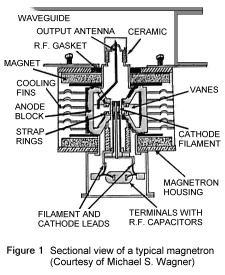How Microwave Ovens Produce Microwaves
A wave transports energy. So let's
follow the energy through a microwave oven to the food. A
microwave oven obtains electrical energy from the power company,
because it is plugged into the wall. It receives electricity at
110 Volts. To produce microwaves, it needs a higher potential, so
the electric current goes to a transformer, which takes the electricity
from the wall up to 3000 volts. That 3000 volts goes across the
anode (positive terminal) and cathode (negative terminal) of a device
called a magnetron. A magnetron is a vacuum tube that produces
microwaves. There is a diagram of one below.

http://www.gallawa.com/microtech/magnetron.html
If you would like the engineer's version of how a magnetron works,
click on the link above. The short and quick version is as
follows: Electrons leave the cathode. They travel in a curved
path to the anode because permanent magnets create a magnetic field
that curves their path. As they circle to the anode they create
an radio field (RF) in cavity spaces that surround the anode.
Microwaves from this field then travel to the microwave cavity-taking
the energy from the electrons to the food being heated. Microwave
ovens also contain a stirrer that the waves pass through so they are
more evenly distributed inside. This is also why microwave ovens have
turntables: it carries the food around in case the microwaves are not
evenly distributed by the stirrer.
|

